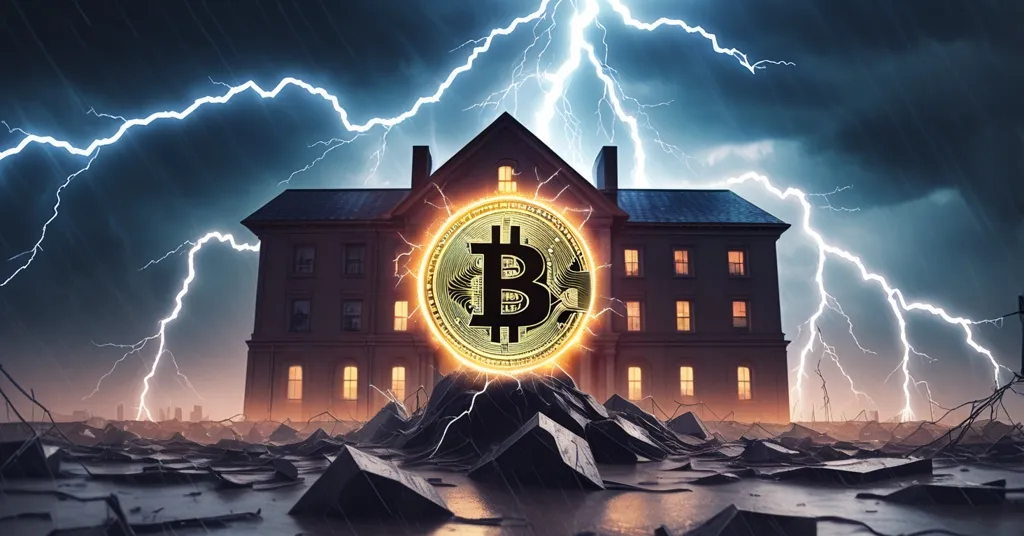Bitcoin $1.6B Liquidation Chaos: Can RentStac (RNS) Real Estate Tokens Save Investors?

Bitcoin Liquidations Slam $1.6B: Can RentStac (RNS) Real Estate Tokens Shield Investors?
A staggering $1.6 billion in Bitcoin positions vanished in just hours, a brutal reminder of the crypto market’s savage volatility that can torch portfolios without mercy. Amid this wreckage, RentStac (RNS) steps forward with a daring pitch: tokens backed by income-generating real estate to offer stability and passive income, a potential refuge from the chaos of digital asset crashes.
- Bitcoin Bloodbath: $1.6 billion in positions liquidated in under 24 hours due to cascading sell-offs.
- RentStac’s Anchor: RNS links tokens to real-world real estate, aiming to dodge crypto’s wild swings.
- Key Promises: Token buybacks, transparent payouts, and security features to protect investors.
Bitcoin Liquidation Carnage: What Happened?
The crypto market took a nosedive recently, with over $1.6 billion in Bitcoin positions wiped out in less than a day on major exchanges like Binance and Bybit. This kind of liquidation event isn’t just a bad day at the office—it’s a full-on financial massacre. It typically happens when traders, often using borrowed money (known as leverage), bet big on Bitcoin’s price. If the market tanks suddenly, their collateral can’t cover the loan, triggering automatic sell-offs called margin calls. Think of it like a bank repossessing your car when you miss payments, except it’s instant and merciless, cascading across thousands of accounts as prices spiral lower.
While exact triggers for this specific event remain murky, such crashes often tie to broader factors—think Federal Reserve rate hikes spooking investors, regulatory crackdowns, or even a whale dumping massive holdings. Historical context shows this isn’t a one-off; similar liquidations hit $1.2 billion during a March 2020 flash crash tied to COVID panic. The lesson? Bitcoin’s dominance means when it bleeds, the entire market feels the pain. For leveraged traders, it’s a high-stakes game where one wrong move—or one bad headline—can obliterate years of gains.
The Volatility Trap in Crypto
Bitcoin’s price swings are legendary, a rollercoaster that can make or break fortunes overnight. That $1.6 billion wipeout isn’t just numbers on a screen; it’s real people losing real money, often because they overextended themselves chasing moonshot gains. This volatility is baked into crypto’s DNA—decentralized assets don’t bow to central banks or stabilizers, which is both their strength and their curse. It’s why Bitcoin remains a beacon of freedom for many, but also a landmine for the unprepared.
The broader market isn’t much safer. Altcoins often mimic Bitcoin’s moves, amplifying losses during downturns. Leveraged trading, while tempting with its promise of outsized returns, turns small dips into catastrophic losses. So, as portfolios burn, the question looms: is there a way to play in crypto without getting scorched by its manic cycles? This is where projects like RentStac (RNS) enter the fray, offering a different path—one grounded in something more tangible than memes or hype.
RentStac’s Real Estate Play: A Stable Haven?
RentStac (RNS) isn’t your typical cryptocurrency. While most tokens ride the waves of speculation—fueled by little more than social media buzz and empty promises—RNS ties its value to income-generating real estate. The concept, often called real-world asset (RWA) tokenization, lets investors own fractional shares of properties via blockchain, blending the old-school dependability of bricks and mortar with crypto’s borderless liquidity. In a market where Bitcoin can shed 20% overnight, RentStac’s pitch of stability and passive income sounds almost too sane to be true.
The idea isn’t brand new. Since around 2017, platforms have tinkered with tokenizing real estate to democratize access—think owning a slice of a Manhattan/bo condo for $50. But RentStac sharpens the focus on insulation from crypto chaos. Their tokens represent stakes in properties that generate rent, offering a buffer when digital assets implode. It’s not about getting rich quick; it’s about not getting poor quicker. For investors shell-shocked by liquidations, that alone might be worth a second look.
How RentStac (RNS) Works: Mechanics and Features
Let’s break down the nuts and bolts of RentStac’s model. Their real estate holdings are managed through Special Purpose Vehicles (SPVs), legal entities that act like separate bank accounts for each investment. If one property deal flops—say, a tenant skips town or a market crashes—that failure doesn’t drag down the whole portfolio. It’s a firewall for risk, ensuring one bad apple doesn’t spoil the bunch.
Income from these properties, like monthly rents, funds two key mechanisms. First, systematic token buybacks: RentStac uses profits to buy RNS tokens off the market and remove them from circulation permanently. Less supply, in theory, means higher value—much like a rare comic book appreciating because only a few exist. Second, profits are distributed to token holders automatically via smart contracts, which are self-executing bits of code on the blockchain. No middleman, no delays—just transparent, tamper-proof payouts anyone can verify on-chain.
Security isn’t an afterthought either. RentStac uses multi-signature escrow wallets, meaning funds need multiple approvals before they’re touched. These are only released for verified real estate purchases or pre-set milestones, a damn solid shield in a space crawling with rug-pulls and scams. For a practical example, their presale offered a $1,000 investment at $0.025 per token with a 100% bonus, effectively costing $0.0125 per token, netting 80,000 RNS. Unlike traditional real estate, where selling takes months, these tokens can trade on secondary markets for instant liquidity—assuming there’s demand, of course.
Risks and Challenges: No Free Lunch
Before we get too cozy with RentStac’s vision, let’s slap on some reality goggles. Tokenizing real estate sounds slick, but regulatory roadblocks could gut this project faster than a Bitcoin flash crash. Different countries have wildly different rules—some, like the U.S., have seen the SEC hammer down on similar offerings, labeling them unregistered securities. Others outright ban such tokens. If RentStac hasn’t ironed out these legal wrinkles, they’re playing with fire.
Then there’s the operational mess. Real estate isn’t a clean line of code; it’s a gritty business of leaky roofs, deadbeat tenants, and local market slumps. And let’s not forget—real estate isn’t always “stable.” Remember 2008? Housing bubbles burst, and no smart contract can patch that hole. Plus, RentStac hasn’t publicly detailed specific properties or yields. Without hard evidence of execution, this transparency talk risks being just hot air—a red flag in a space where trust is already thinner than a paper wallet.
Market adoption is another gamble. Instant liquidity only works if people are trading RNS tokens. If volumes are low or exchanges don’t list them, you’re stuck with digital IOUs that no one wants. We’ve seen altcoins promise the world on liquidity, only to flop into obscurity. RentStac might have a shiny model, but if the market yawns, good luck cashing out.
The Bigger Picture: Real-World Assets in Blockchain
Zooming out, RentStac is part of a growing wave of projects tying blockchain to real-world assets (RWAs). From tokenized gold to art to debt instruments, the push is on to make crypto less of a speculative casino and more of a diversified financial toolbox. It’s a trend worth watching—projects like Harbor and Polymath have dabbled in this space since the late 2010s, though many hit snags with regulation or adoption. Failures litter the path, but successes could redefine how we invest, bridging the gap between crypto’s Wild West and traditional finance’s stuffy boardrooms.
From an accelerationist lens, this is exciting. Tokenized assets could disrupt real estate’s gatekeepers—think no more bloated middlemen or decade-long lockups. But a nagging doubt persists: are these projects truly decentralized, or just shiny new intermediaries wearing a blockchain mask? RentStac’s model raises that question loud and clear. If it’s more centralized than it lets on, it might clash with the very ethos of freedom and privacy we champion.
Bitcoin Maximalist Take: Innovation or Distraction?
As a Bitcoin maximalist at heart, I’ve got to throw in a reality check. Bitcoin is the king for a reason—its decentralization, censorship resistance, and store-of-value status are unmatched. No tokenized real estate play, no matter how clever, embodies that raw, rebellious spirit of sovereign money. RentStac and similar projects fill a niche, sure, diversifying risk for jittery investors. But do we even want “stability” if it means drifting from crypto’s core mission? Part of me says let the volatility rage—it’s the price of freedom. Still, I’ll concede there’s room for experiments like RNS, especially for those who can’t stomach another $1.6 billion gut-punch.
Key Takeaways and Questions on Bitcoin and RentStac
- What caused the $1.6 billion Bitcoin liquidation event?
Sharp price drops triggered margin calls on over-leveraged positions, forcing automatic sell-offs across major exchanges in under 24 hours, likely fueled by market panic or external economic pressures. - Why are Bitcoin liquidations so devastating for the crypto market?
Bitcoin’s dominance means its crashes ripple through altcoins, while leveraged trading amplifies losses, wiping out billions and shaking investor confidence in minutes. - How does RentStac (RNS) differ from typical cryptocurrencies?
Unlike speculative tokens driven by hype, RNS is backed by income-producing real estate, aiming to provide a tangible value base and shield against market swings. - What benefits does RentStac offer during crypto volatility?
It promises stability via real-world assets, passive income from property rents, value growth through token buybacks, and liquidity with tradable tokens on secondary markets. - How do real estate tokens work in crypto?
They represent fractional ownership in properties via blockchain, allowing investors to buy, sell, or earn income from real estate without direct ownership or lengthy lockups. - How secure and transparent is RentStac for investors?
It uses multi-signature escrow wallets for fund protection, audited smart contracts for automated payouts, and on-chain records for verifiable transparency—a strong start in a scam-ridden space. - Can RentStac compete with Bitcoin’s store of value?
Unlikely. Bitcoin’s unmatched decentralization and scarcity make it a unique asset; RNS offers diversification, not a replacement for BTC’s core ethos. - Is RentStac a safe investment during Bitcoin crashes?
It’s not guaranteed. While asset backing offers a buffer, risks like regulatory bans, property management issues, and low token adoption could undermine its safety net.
So, where do we stand? RentStac (RNS) is a bold stab at taming crypto’s wild side, melding real estate’s slow grind with blockchain’s boundless potential. It’s not a Bitcoin killer—nothing is—but it could carve a niche for those craving a breather from liquidation nightmares. Yet, the hurdles are steep, from legal landmines to unproven execution. The crypto space desperately needs projects grounded in reality over pump-and-dump nonsense, and RentStac might fit that bill if it delivers. Until then, tread carefully. Hedge your bets, keep Bitcoin as your bedrock, and question whether stability is crypto’s savior—or its surrender.



